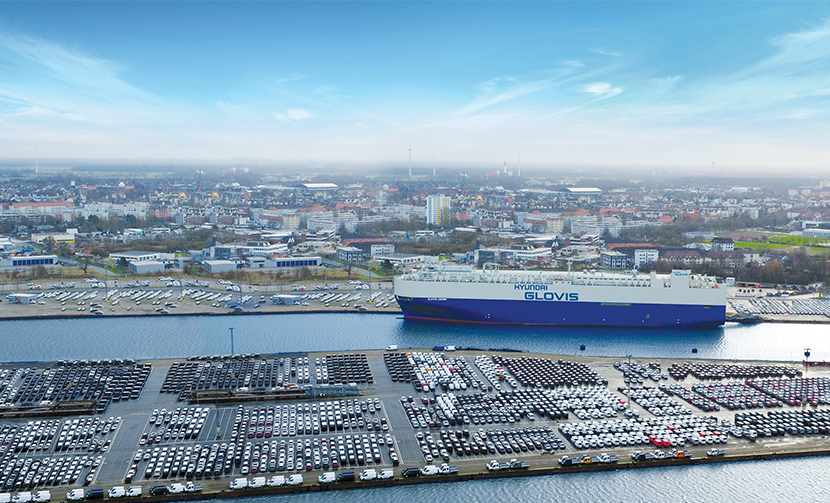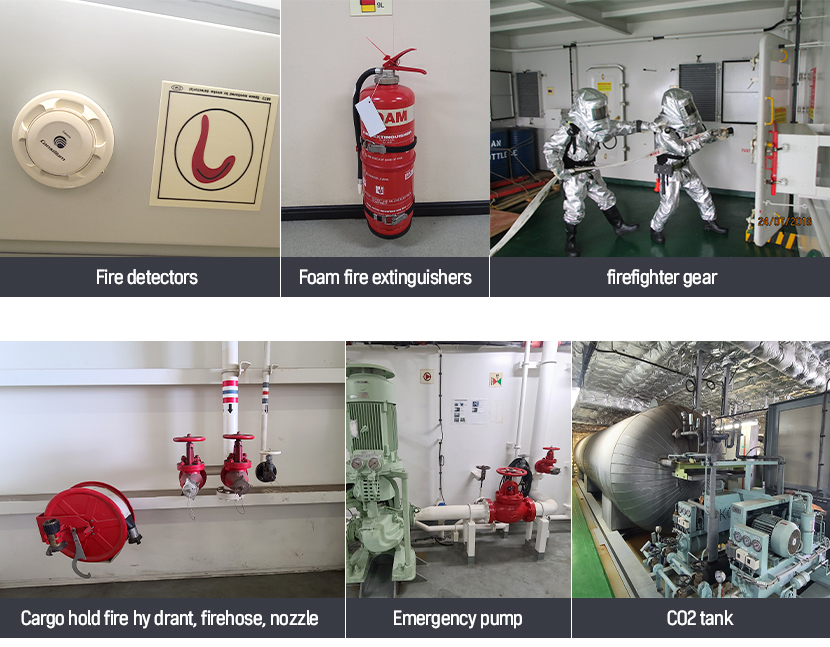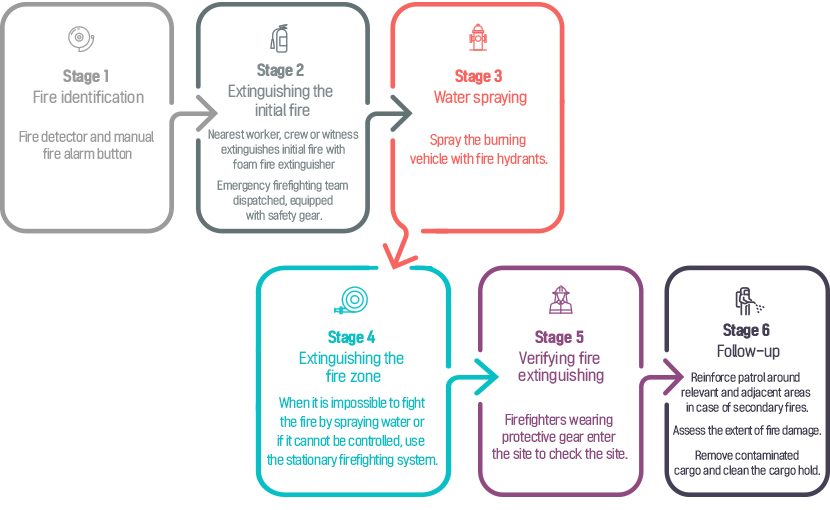Hyundai Glovis has set up a customized fire response system for shipping of finished vehicles through joint research and development with Korean Register, and is sequentially applying the system to each of its vessels. The new fire response system is significant as it can prevent onboard fires resulting from an increase in the global shipping volume of electric vehicles. It can also preemptively secure crew safety in accordance with the laws of fire prevention and penalties for serious accidents. We talked with General Manager Baek Beon of the Maritime Safety Management Team, who participated in the research and development of the new system, to find out about its necessity, development, and process.

Q. What was the motivation for setting up a fire response system?
Ships serve the purpose of loading and transporting cargo at sea. We have a system that is self-powered and is in motion around the clock. Within this limited space, there are power plants, factories, warehouses, and crew quarters just like on land, and crew members live inside this space. Fires can thus be caused by a variety of factors in any area, and if it spreads into a large-scale fire, it becomes very difficult to suppress. Naturally we already have fire safety measures in place. High-risk sections, such as areas where fuel oil or fire-hazard cargos are handled or the kitchen where high-temperature tools are frequently used, are equipped with special fire detection and extinguishing systems.
In the case of vehicle cargo ships, apart from special cargo, most shipments are not classified as high-risk. The applicable fire-related regulations are thus the same as for general cargo ships. However, in recent years, with the increase in demand for electric vehicles, news of fire-related incidents such as those caused by electric batteries have also been on the rise, forcing the industry to take greater interest in the characteristics of electric vehicle fires. As a shipping company with the highest ratio of electric vehicles transported among global auto shipping companies, Hyundai Glovis proceeded with the research following the decision that it was necessary to take the lead in setting up countermeasures for response to fire situations that can occur during shipping.
Q. What is the current level or legal standard for fire response in Korean and overseas shipping?
All ships engaged in international voyages, including ours, are equipped with a fire response system certified by Korean Register in accordance with SOLAS (International Convention for the Safety of Life at Sea) regulations. In particular, about 1,000 detectors are installed in the cargo area of all vehicle cargo ships. These detectors promptly detect fires via smoke and heat and automatically set off alarms. There are more than 250 fire extinguishers and fire hydrants located around each ship, and a stationary firefighting system is also in place that separates and seals off designated areas in case of a fire and sprays CO2 to extinguish a fire.
Q. When and how widely is the fire response system set to be applied?
In the case of our own vessels, fire response materials have been supplied sequentially since last April. Onboard training is being conducted on ships that have been supplied with the materials so that they can be used in case of an emergency. This training is based on revised fire response procedures and scenarios distributed to the ships.
However, in the case of charter vessels, the ship owners themselves are responsible for fire prevention and response, but we will be supplying them with the same materials for the safety of our cargo. We plan to apply them sequentially from May.
Q. What is the expected effect of the fire response system?
First, I believe that it is meaningful for us to provide a solution that can be mobilized on the ship itself that can respond to a certain extent when a fire occurs from the battery of an electric vehicle. Above all, considering that the existing fire response system did not have a procedure for controlling the spread of fire in the cargo unit during the initial stage, this improved response system extinguishes the fire at the point of ignition and keeps the area controlled. We thus expect that it will reduce the scope of damage even in the event of a fire.
“With the fire response system, we can prevent large-scale fires and protect the safety of our ships, cargo, and crew.”
Q. How was the development process with Korean Register?
A total of four people including myself worked together for six months to develop the fire response system. They include the shipping technology support manager from the G-Marine Service Technical Team and two working-level researchers from Korean Register. First, the G-Marine Service Technical Team, which supports shipping technology, conducted studies by collecting international research and experimental data on electric vehicle battery fires. Through regular video conferences, we tried to narrow down the scope to response measures appropriate for the shipping environment. Hyundai Glovis and Korean Register shared the research content and supplemented the mutual findings, and we were finally able to develop an improved fire response system.
Q. What kinds of issues were encountered during the development of the fire response system?
When we proposed this joint study on electric vehicle fire response on cargo ships to the Korean Register, they were aware of the need, but seemed unsure of where to start or how to approach the issue. As the project manager, I also felt similar difficulties. It was important to draw out and combine the knowledge of experts in each field to drive results, but our research period coincided with when the COVID-19 situation was the most severe in Korea. It was somewhat frustrating because we could only communicate via video conferencing and site visits were limited. Whenever we had a video meeting, I used to say that I would go down to the Korean Register headquarters in Busan once the COVID situation had improved and treat them to lunch, but six months has already passed since then.
Q. What are the advantages of the fire response system in terms of prevention and suppression?
Our research was largely divided into structural changes that can be applied to new ships in the future and in areas that require high-cost investments, together with areas where high efficiency can be achieved at low cost for existing ships. From the perspective of our company, which operates multiple ships, I believe the design of an efficient system that can be applied immediately to existing ships is what sets this system apart. Also, although it was applied as a fire response method for electric vehicles, I think it is also effective for controlling fires that occur with existing internal combustion engine (ICE) vehicles as well.
Q. Are there any behind-the-scenes stories that you would like to share?
I already talked about how the development of this fire response system started, but I had no idea that this topic would receive so much attention. At the beginning of the study, there had not been any discussions about risk assessment and research for establishing regulations on the transport of electric vehicle batteries even at the International Maritime Organization (IMO) level. However, with environmental problems recently emerging as serious issues, the demand for electric vehicles has increased rapidly and the shipping volume has risen accordingly. There is news that the IMO has started their own research, and related actions have started among overseas registers as well. I don’t know when the regulations will come into effect, but I can cautiously predict that within the next few years we will probably need vehicle cargo ships that require advanced fire response equipment.
“It has been made possible to take a preemptive response to vehicle fires resulting from the increase in shipping volume of finished vehicles.”

Q. How would you describe the proper fire response process?
A ship’s fire response process is largely divided into the stages of fire detection, on-site response (fire extinguisher), sending in an emergency firefighting team, and implementing the stationary firefighting system, and detailed instructions are provided for each stage. The new system can be applied for the stages of on-site response (fire extinguisher) and sending in an emergency firefighting team. The firefighting method is as follows: Use a car fire blanket with 1,500-degree heat resistance, known to be effective for electric vehicle fires, to cover the target at the initial stage to block oxygen, thereby preventing the spread of the fire and slowing the spread of smoke in the area. Next, spray a mist of water onto the car fire blanket and inside the vehicle using a water mist lance to cool the battery. This process has been applied for the first time among global shipping companies.
To add to my explanation on the special equipment, car fire blankets started being used in Europe to respond to electric vehicle fires, and have also started being used in Korean fire departments. Water mist lances are used in container ships to fight fires occurring inside containers. By combining these two devices and applying them to vehicle cargo ships, an effective fire response system has been put into place for existing ships. In addition, we are conducting pilot tests that apply an AI-based smart fire monitoring system to CCTV units that have recently been installed on board. We are hoping to enable faster fire detection and response through these efforts.
Q. Can you tell us about the fire response training process?
There are response scenarios for each situation and zone according to the fire response process mentioned above, and members of each rank are assigned their respective roles. In order to respond promptly in the event of an emergency, emergency response drills are conducted at least once a month, and electric vehicle fire response scenarios have been added for various emergency situations. If you are interested in this subject, even though it is not for electric vehicle fire response training, you can search for “Emergency fire extinguishing training on ships” on YouTube, and you will find plenty of related materials.
Swipe left or right to view additional photos.
Writer Editorial Department
2022.05.26












